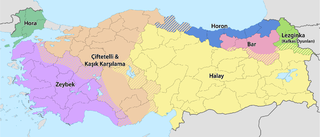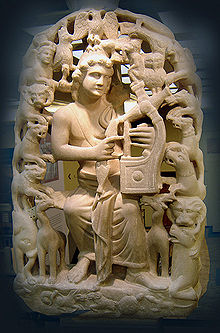
The music of Greece is as diverse and celebrated as its history. Greek music separates into two parts: Greek traditional music and Byzantine music, with more eastern sounds. These compositions have existed for millennia: they originated in the Byzantine period and Greek antiquity; there is a continuous development which appears in the language, the rhythm, the structure and the melody. Music is a significant aspect of Hellenic culture, both within Greece and in the diaspora.

Sirtaki or syrtaki is a popular dance of Greek origin, choreographed by Giorgos Provias for the 1964 film Zorba the Greek. It is a recent Greek folkdance, and a mixture of the slow and fast rhythms of the hasapiko and hasaposerviko dance respectively. The dance and the accompanying music by Míkis Theodorakis are also called Zorbá's dance, Zorbas, or "the dance of Zorba".

Circle dance, or chain dance, is a style of dance done in a circle or semicircle to musical accompaniment, such as rhythm instruments and singing. Circle dancing is probably the oldest known dance formation and was part of community life from when people first started to dance.

The hasapiko is a Greek folk dance from Constantinople. The dance originated in the Middle Ages as a battle mime with swords performed by the Greek butchers' guild, which adopted it from the military of the Byzantine era. In Constantinople during the Byzantine times, it was called in Greek μακελλάρικος χορός. Some Greeks, however, reserve the latter term only for the fast version of the dance.

Antikristos or Antikrystós is a dance of Greek origin. “Aντικρυστός” in Greek language refers to the verb αντικρύζω “be across, opposite, face-to-face”. It is also known in Armenia. Antikristos, has similarities with karsilamas dance. It is danced in couples.

Zeibekiko is a Greek folk dance.

Kochari (Armenian: Քոչարի, is an Armenian folk dance.

Ikariotikos or Kariotikos is a traditional dance and accompanying song originating in Ikaria a Greek island in the North Eastern Aegean Sea. Some specialists say that the traditional Ikariotikos was slow and the quick "version" of it, is a Ballos. The name Kariotikos is mostly used by the locals of Ikaria.

Sousta is the name of a folk dance in Cyprus and Crete which is danced in Greece and generally in the Balkans. The music is generally played with a lyre, laouto, and mandolin.
The Tsamikos or Kleftikos is a popular traditional folk dance of Greece, done to music of 3/4 meter.

Greek folk music includes a variety of Greek styles played by ethnic Greeks in Greece, Cyprus, Australia, the United States and elsewhere. Apart from the common music found all-around Greece, there are distinct types of folk music, sometimes related to the history or simply the taste of the specific places.

Turkish folk dances are the folk dances of Turkey. Facing three seas, straddling important trade routes, Turkey has a complex, sophisticated culture, reflected in the variety of its dances. The dominant dance forms are types of line dance. There are many different types of folk dances performed in various ways in Turkey, and these reflect the cultural structure of each region. The 'Bar' in Erzurum province, the 'Halay' in the East and Southeast, the 'Hora' in Thrace, the 'Horon' in the Black Sea, 'Spoon dances' in and around Konya and 'Lezginka' in Kars and Ardahan are the best known examples of these.

Horon (Greek) or khoron, which is related to Modern Greek χορός (chorós), refers to a group of a circle folk dances from the Black Sea region of Turkey.

The Kalamatianós is one of the best known dances of Greece. It is a popular Greek folkdance throughout Greece, Cyprus and internationally and is often performed at many social gatherings worldwide. As is the case with most Greek folk dances, it is danced in circle with a counterclockwise rotation, the dancers holding hands.

Syrtos is, in classical and modern Greece: a folk dance in which the dancers link hands to form a chain or circle, headed by a leader who intermittently breaks away to perform improvised steps.

Nisiotika is the name of the songs and dances of Greek islands including a variety of Greek styles, played by ethnic Greeks in Greece, Cyprus, Australia, the United States and elsewhere.
The Tsifteteli, is a rhythm and dance of Anatolia and the Balkans with a rhythmic pattern of 2/4. In Turkish the word means "double stringed", taken from the violin playing style that is practiced in this kind of music. There are suggestions that the dance existed in ancient Greece, known as the Aristophanic dance Cordax. But the dominant theory associates it with middle eastern civilization, as no similar dance ever existed in the tradition of Greece or any other European country, until very recently. Nowadays it is to be found not only in Greece and Turkey, but also in the whole of the Southeastern Mediterranean region.
European dances refers to various dances originating in Europe. Since Medieval ages, European dances tend to be refined, as they are based on the court dances of aristocrats.







